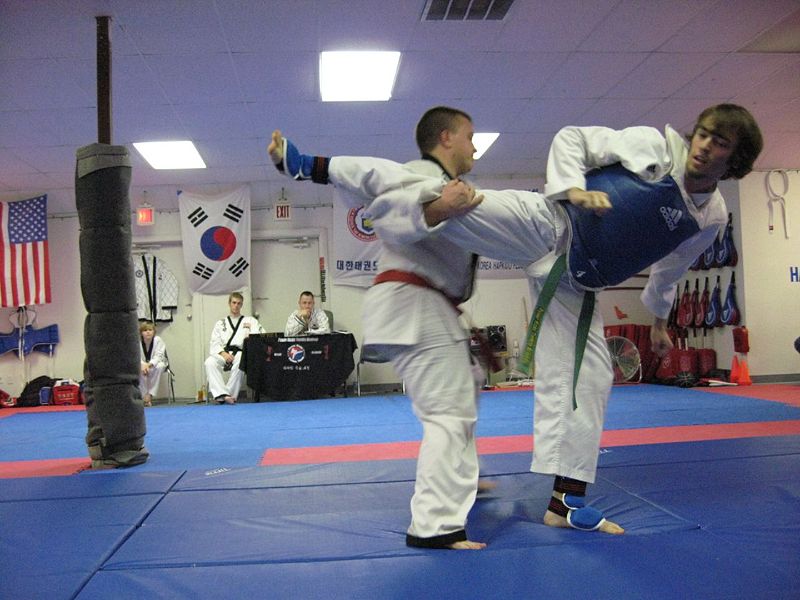Hapkido

Hapkido is the Korean style of martial art, which has gained a huge following because it is a practical type of self-defense. The popularity of Hapkido’s techniques work because a practitioner does not need to be large or have to havea sny great strength for it to be effectively delivered.
The techniques, philosophy and principles are the key to unlocking the body’s confidence and strength that are deeply within each person regardless of sex, muscle mass or even age.
In Hapkido the name means "The way of coordination and internal power." Hapkido is considered as a complete martial art because it consists of some dynamic kicking and striking techniques, it is quite similar to Tae Kwon Do, both have soft and hard style deflection techniques, together with throws, ground fighting, takedowns, and an extensive joint locking technique. Hapkido is a combination of two schools of Korean Martial Arts - Yool Sool which derives from the Japanese art well-known as Daito-Ryu Aiki-Jutsu and also Tae Kyon which is a very ancient Korean style Kicking Skill, known and widespread during the Three Kingdoms time.
Some of the earlier history is con
Both Hapkido and Aikido both have some significant similarities to the Daito Ryu Aikijujutsu. Choi returned to Korea when the grandmaster died, and he began to study the Korean arts, at the same time teaching Yawara or Yu Sool, other names for Jujutsu and eventually ended up calling his kwan (which means school) the Hapki Kwan.
Ji, Han Jae is reputed to be the ‘father’ of ‘modern hapkido; He studied under Choi, and later began his own school, and he taught what he termed his style as Hapkido. As time went by, Hapkido adopted techniques from different disciplines such as: Tae Kyon and Tang Soo Do, plus other Korean kwans – ‘schools’. Some Korean sources tend to put emphasis on the Korean lineage of the arts of Hapkido over and above the Aikijujutsu lineage, although some omitting the connection to Aikijujutsu, however, as seen above, the connection can be shown in the techniques.
There are many people might categorize Hapkido as a type of "scientific" martial art, each aspect of the art is geared towards one single purpose: to incapacitating ones opponent in the most effective, efficient and as thorough a manner possible, and the best way con
The simplest explanation or definition of the theory can be observed in the word Hapkido which is briefly translated as: "The art of coordinating energy."
HAP means coordination, harmony means KI-energy and DO means art form and Dynamic motion, means lightening quick reaction. Reacting dynamically means to be more than just quick reaction. Reacting dynamically; is to create balance and harmony between two opposition forces and to make use of it for your own advantage. Yang and Um, also known as the concept of balance, is con
Balance is created in the three principles of hapkido:
1. Circle
2. Water
3. Sum
Each principle is important in its own right, they all originate from ‘The Theory of Circular motion’.
”The Theory of Circular motion”: submits that a person’s body must become the ‘dynamic center of motion’. It is likened to a spinning top, the body should be in a continuous motional state, in order to maintain its balance, however, con
“The Theory of Water”: submits that the body movements be fluid and likened to water. Therefore, the techniques must be easily adaptable. The water that flows in a river, will with the current pull a pebble, then travel around a fixed boulder, and even carve a valley in the rock itself.
And lastly: ‘The Theory of Sum”, or using the idea of the opponents own energy against the opponents self. This theory is combination of the above two, fluid motion which works towards the most destructive force. A good example is a hurricane, the air spins around and absorbs everything all at the same time it throws everything off, and the motion is continuous. There is very little that can withstand the force of a hurricane.
Hapkido takes the ‘Theory of Dynamics’ and combines it with a complete knowledge of vital parts of the human body. When one con
This knowledge is important to affect a successful defense or attack.
Hapkido is the way of mental and physical coordination, it requires coordination of body and mind in every movement, and to maintain this coordination is needs to be practiced constantly.

